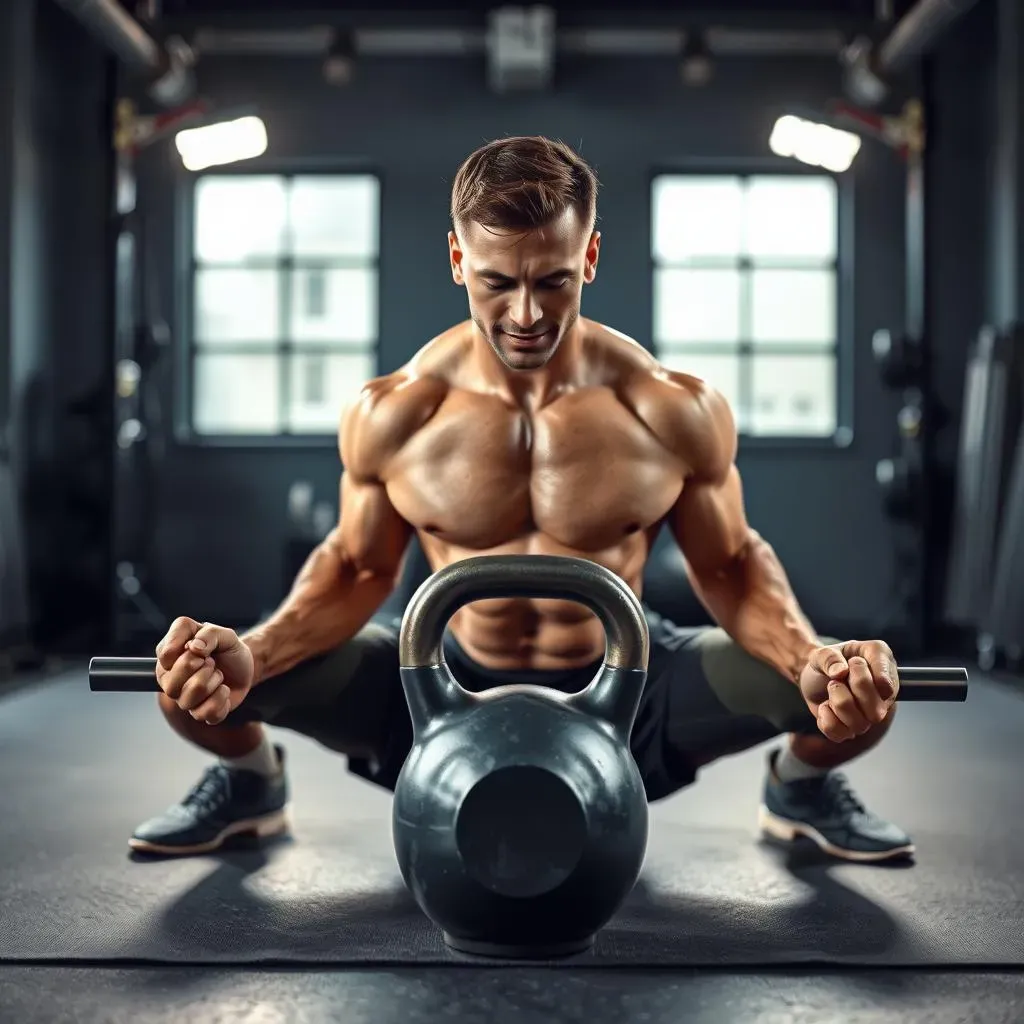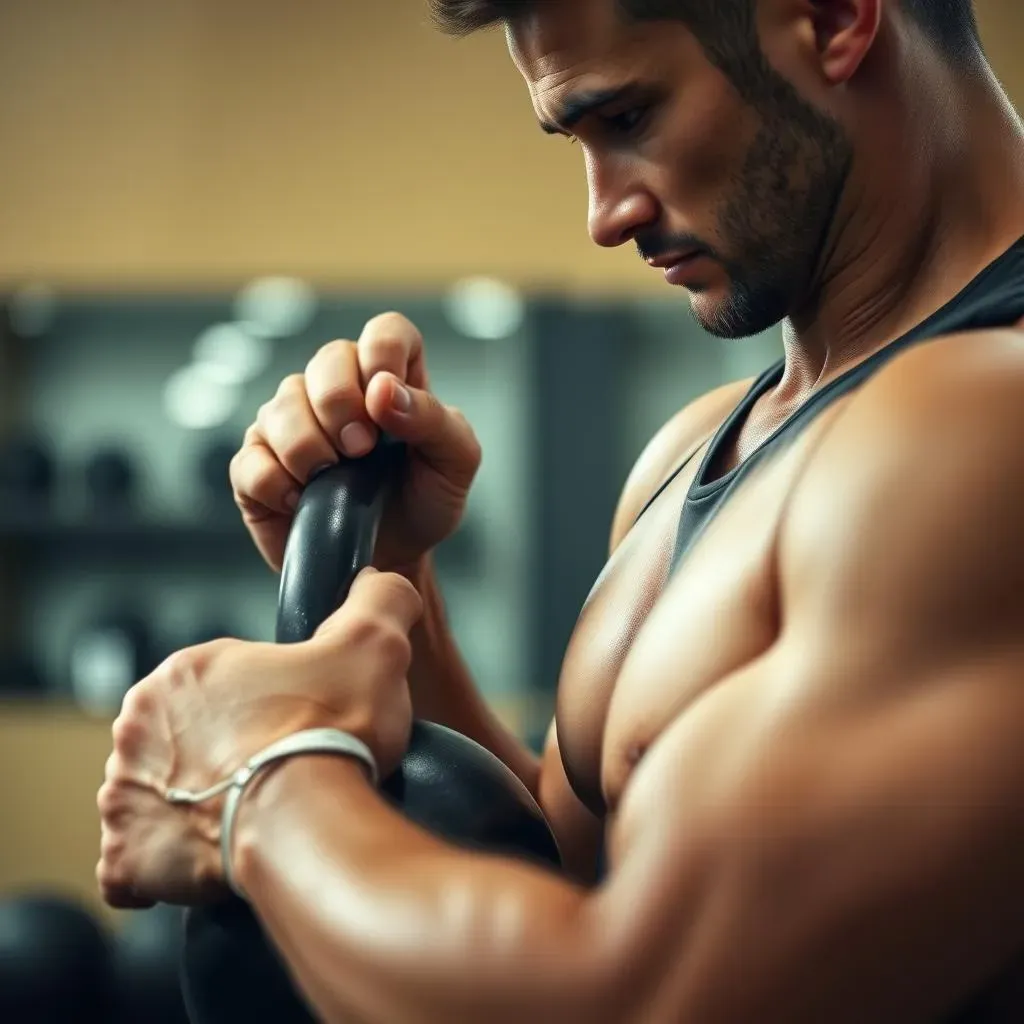Table of Contents
Ever feel like your chest workouts are missing something? Maybe you're tired of the same old bench presses and push-ups. What if I told you that you could get a fantastic chest workout with just one piece of equipment? Yep, you guessed it: a kettlebell. This article is your guide to unlocking the power of the kettlebell for serious chest gains. We will skip the fancy gym machines and focus on effective, straightforward movements that will help you build muscle and strength. We’ll start with a quick look at your chest muscles, then move onto why kettlebells are a great choice. You'll learn specific exercises and how to put them all together into one killer "one kettlebell chest workout". So, whether you're a seasoned lifter or just starting out, get ready to transform your chest training with the humble kettlebell.
Understanding Your Chest Muscles

Understanding Your Chest Muscles
The Pectoralis Major: Your Powerhouse
let's talk chest muscles, or as the fancy folks call them, the pectorals. The big guy here is the pectoralis major. Think of it as the main event, the muscle that gives your chest its shape and power. It's actually a big fan-shaped muscle that covers most of your upper chest.
This muscle is responsible for a lot, like bringing your arms across your body, rotating them inwards, and even helping with those push-ups you're probably doing (or should be!). It's got a few parts – the clavicular (upper chest) and the sternal (lower chest) – but they all work together to get things done. So, when you're doing a chest press, you're calling this bad boy into action.
The Pectoralis Minor: The Supporting Act
Now, don't forget about the pectoralis minor. It’s like the quiet supporting actor that works behind the scenes. It sits underneath the pectoralis major and is a smaller, triangular muscle.
Its job is to pull your shoulder blades forward and down. You might not see it bulging out, but it plays a crucial role in shoulder stability and movement. It's like the unsung hero of chest training, making sure everything is aligned. When you train your chest, both of these muscles get in on the action, working together to give you a strong, well-rounded upper body.
Muscle | Main Function | Location |
|---|---|---|
Pectoralis Major | Adduction, internal rotation, and flexion of the humerus | Covers most of the upper chest |
Pectoralis Minor | Stabilizes the scapula and draws it downward and forward | Underneath the pectoralis major |
Kettlebell Chest Training: Why and How

Kettlebell Chest Training: Why and How
Why Choose Kettlebells for Chest Training?
so you might be thinking, "Kettlebells for chest? Isn't that more for swings and squats?" I get it. But hear me out. Kettlebells are awesome for chest training because they offer a unique challenge. Unlike dumbbells, the weight isn't evenly distributed, which forces your muscles to work harder to stabilize the weight. This means you get more bang for your buck, engaging more muscles and building strength in ways that traditional weights sometimes miss. Plus, they're super versatile. You can do presses, flyes, and even some unusual movements that hit your chest from different angles.
Another cool thing about kettlebells is that they're great for functional strength. Think about it: when do you ever lift something that is perfectly balanced like a dumbbell in real life? Kettlebells mimic real-world movements more closely, improving your strength and coordination in everyday life. And let's be honest, they look pretty cool too.
How to Train Your Chest with Kettlebells
So, how do you actually use a kettlebell to train your chest? It’s actually quite simple. We're going to focus on what I call "grinds" - slow, controlled movements that really make your muscles work. Think slow and steady, not fast and jerky. This will help you build a strong chest.
We’ll use a variety of exercises that work your chest from different angles, similar to what you would do with dumbbells. The key is to focus on form and control. Don't worry about lifting the heaviest weight right away. Start light and focus on getting the movement right. As you get stronger, you can gradually increase the weight or reps. It’s all about progress, not perfection.
Benefit | Why It Matters |
|---|---|
Unique Weight Distribution | Engages more stabilizer muscles, leading to better overall strength |
Versatility | Allows for a wide range of exercises, hitting the chest from various angles |
Functional Strength | Mimics real-world movements, improving strength and coordination |
Grinds | Slow and controlled movements that make your muscles work harder |
Best Kettlebell Exercises for Your Chest

Best Kettlebell Exercises for Your Chest
Kettlebell Floor Press
Alright, let's get into the good stuff, the exercises! First up, we've got the kettlebell floor press. This one is a classic for a reason. Lie on your back with your knees bent and feet flat on the floor. Grab the kettlebell with one hand and hold it by your chest. Now, press the kettlebell straight up towards the ceiling, keeping your elbow slightly bent. Slowly lower it back down to your chest. Boom! You've just done a floor press.
What’s great about this exercise is that the floor limits your range of motion, which can be beneficial if you have any shoulder issues. It really isolates the chest muscles and focuses on pushing power. And you can do it at home, no bench required, just some floor space and your kettlebell. Start with a weight you can comfortably manage for 8-12 reps.
Kettlebell Floor Fly
Next, let's try the kettlebell floor fly. This one is a bit different from the press, as it targets the chest from a different angle. Lie on your back again, holding the kettlebell with both hands, and extend your arms straight up towards the ceiling. Now, slowly lower the kettlebell down towards the floor, keeping a slight bend in your elbows, and imagine you're giving someone a big hug. Lower as far as you comfortably can without straining your shoulders, then bring the kettlebell back up to the starting position.
The fly is fantastic for stretching and working the chest muscles. It's not about lifting heavy here, but about controlled movement and feeling the stretch. Start with a lighter weight to get the hang of the movement. This exercise will help you build chest strength and get a good pec stretch. It’s a great exercise for those looking to hit the chest muscles from a different angle.
Exercise | Main Focus | Reps |
|---|---|---|
Kettlebell Floor Press | Pushing strength, chest isolation | 8-12 |
Kettlebell Floor Fly | Chest stretch, muscle activation | 10-15 |
Kettlebell Seesaw Press
last but not least, let's try the kettlebell seesaw press. This one is a fun twist on the classic press. Start by lying on your back with a kettlebell in each hand. Press one kettlebell up towards the ceiling, while the other stays at your chest. Now, lower the first kettlebell back down and press the other one up. It’s like you’re seesawing the kettlebells, going up and down.
The seesaw press is great for building strength and coordination. It also challenges your core muscles as they work to keep you stable while you’re moving the weights. This exercise is a bit more advanced, so start with a lighter weight and focus on keeping the movement controlled. It is a great way to get a full chest workout with just kettlebells. Remember, it's not about how much you lift but how well you lift!
Creating Your One Kettlebell Chest Workout

Creating Your One Kettlebell Chest Workout
Putting It All Together
Alright, so you've got the exercises down, now let's talk about putting together your very own "one kettlebell chest workout". First thing's first, don’t just jump in and start throwing around the kettlebell like it's a toy. We need a plan. Think of your workout like a recipe: you need the right ingredients (exercises), the right amounts (reps and sets), and the right method (rest and recovery) to make it work. The beauty of it is, you can tailor this to your own fitness level and goals. Are you trying to build serious muscle, or just want to get stronger? That will change how we approach this.
For example, if you're just starting out, focus on mastering the movements with lighter weights and higher reps. This will help you build a solid foundation and get comfortable with the exercises. If you're more experienced, you can start increasing the weight and decreasing the reps. Remember, it's not a race, it's a journey. Consistency and proper form are key to seeing results.
Sample Workout Structure
Let's get down to the nitty-gritty and put together an example workout plan. We’ll aim for a good mix of exercises and rep ranges to hit your chest from different angles. Remember to warm up before you start, maybe with some light cardio and arm circles. You also should cool down after the workout, some light stretching will do the trick. Here’s a sample workout that you can adjust as you get stronger:
- Warm-up: 5 minutes of light cardio and arm circles.
- Kettlebell Floor Press: 3 sets of 8-12 reps per side.
- Kettlebell Floor Fly: 3 sets of 10-15 reps.
- Kettlebell Seesaw Press: 3 sets of 8-10 reps per side.
- Cool-down: 5 minutes of stretching.
Make sure you are resting for 60-90 seconds in between sets and do not forget to drink water to stay hydrated.
Tips for Success
Before you run off to start your "one kettlebell chest workout", let's go over some final tips to make sure you are getting the most out of your session. First, remember the importance of progressive overload. This means gradually increasing the weight, reps, or sets as you get stronger. Your body is an amazing machine, and it adapts quickly. If you keep doing the same thing, you won't see much progress. So, don’t be afraid to push yourself a bit more each time you work out.
Second, listen to your body. If something doesn't feel right, stop. It's better to take a break than to push through the pain and risk injury. Consistency is key, but so is recovery. Make sure you're getting enough sleep and eating a balanced diet to fuel your workouts and help your muscles recover. And most importantly, have fun! If you're not enjoying your workouts, you're less likely to stick with them. So, find what works for you, be patient with yourself, and get ready to see some serious chest gains.
Tip | Why it Matters |
|---|---|
Progressive Overload | Continuously challenges your muscles to grow stronger |
Listen to Your Body | Prevents injuries and ensures proper recovery |
Consistency | Regular training is key to seeing long-term results |
Have Fun | Makes workouts enjoyable and easier to stick with |
Wrapping Up Your Kettlebell Chest Journey
So, there you have it, a complete guide to building a powerful chest with just one kettlebell. We've covered the basics of chest anatomy, explored why kettlebells are fantastic for chest training, and walked through a variety of effective exercises. Remember, consistency and proper form are key. Don't be afraid to tweak the workouts to fit your needs and always listen to your body. Whether you're aiming for strength or hypertrophy, the kettlebell is a versatile tool that can help you achieve your goals. Now, go grab that kettlebell and start building the chest you've always wanted!